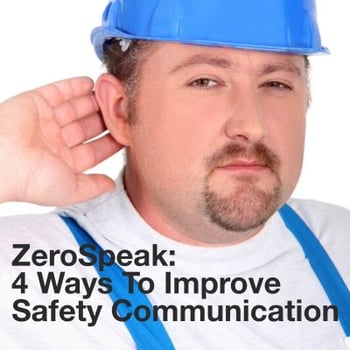ZeroSpeak - 4 Ways To Improve Safety Communication
Your people deserve your best communication effort. Their safety depends on it.
 Zero-Speak. It’s not just a clever name. It’s a mindset and a safety communications philosophy. Zero-Speak is a way of ensuring that you communicate effectively with your people. To move you closer to the ultimate goal of your safety program requires effective communication. If you have to repeat yourself, your people aren't buying-in to what you're saying. They're tolerating safety rules. What you say and how you say it matters. You need to maximize your Zero-Speak opportunities.
Zero-Speak. It’s not just a clever name. It’s a mindset and a safety communications philosophy. Zero-Speak is a way of ensuring that you communicate effectively with your people. To move you closer to the ultimate goal of your safety program requires effective communication. If you have to repeat yourself, your people aren't buying-in to what you're saying. They're tolerating safety rules. What you say and how you say it matters. You need to maximize your Zero-Speak opportunities.
Here are four solid ways to begin implementing a Zero-Speak philosophy in your safety program:
1 One message, one action step, one outcome. Safety meetings have to matter. They must inspire your people to want to improve. But, the more things you add to the discussion, the more muddled the message becomes. Effective communicators know how to prepare a message with a singular and crystal clear focus. There has to be no question in the minds of your people of what the point of the safety meeting was. Ask yourself: what do you want this meeting to cause people to do differently? Then point everything at that ONE thing. If it doesn't fit or support that one outcome, ditch it. Don’t muddle the message by engaging in information-dumps. Keep it short and sweet. Communication is not training. There is no need for stats, figures, charts or graphs. No long boring rambles to make a simple point. In a safety meeting, people want to know why they are there, what you want them to learn and what you expect them to do with that information.
2 Look them in the eye. Eyes darting all over the place make people feel like you’re not listening and you’re not interested in what they have to say or ask. Eye contact makes people feel heard and that their concerns or questions matter. You can’t communicate effectively when you’re multitasking. So, don't shuffle papers, don’t look for responses, don't look away, don't interrupt and don't make a judgment. When you are preparing your response before they are done asking the question, you are not listening to understand. If you’re planning in your head what you’re going to say next, you're not focused on them. You’re almost certain to miss nonverbal cues in the conversation. You need to stay focused on the person in front of you. Stop listening to respond and begin to listen to understand. That means focus fully on the person asking the question.
3 Respect everyone. Your co-workers may not have your certifications in safety but it doesn't mean that they don't want to be safe. They were probably given bad or muddled information in past. Don’t treat them like lesser people. Everyone has different talents. Some of the people you work with enjoy doing some of the things you don't. Your co-workers deserve your respect. They are people like you, with families who care about them. They deserve to live a life of joy too. You may have the title or certification but that doesn't give you the right to suck up all of the oxygen. You're not the only one who gets to speak. No one person is responsible for safety. Everyone is. So it must be a team effort. Don't treat them like children or less-smart. That will only create an us-versus-them culture. Those cultures do not do safety well.
4 Keep it conversational. A conversation means equal amounts of time speaking. A lecture means one person talks and everyone else listens. Lectures are not effective communication. Conversation contributes to understanding. Imagine yourself at a social gathering. How much fun is it when one person speaks all the time and refuses to allow anyone else to speak. Don't be that guy. And, get rid of the childish safety rhymes (without your hardhat, your head will go splat). Same for the innocuous “safety first” themes. They’re not personal and they don’t connect. Themes like Encana’s “Courtesy Matters®” campaign is easily transferred to safety. Try to find a safety program that works without courtesy and respect at it’s very foundation. It’s easy to do safety when you own the theme Courtesy Matters®. You can talk about it. You can have conversations about it. You can find ways to make a theme like that fit around your safety program.
Your people deserve your best communication effort. Not giving them your best is lazy and disrespectful. Be prepared. Rehearse. Listen. Always be on-point. Make it all about them and what they need. Their safety depends on it.
Kevin Burns is a management consultant, safety speaker and author of "The Perfect Safety Meeting." If you want to really drive the safety message home, consider Kevin to speak at your next safety event. He delivers engaging and entertaining keynote safety presentations for everyone: from front-line staff to senior management. He helps people see the light when it comes to buying-in to the safety program.



